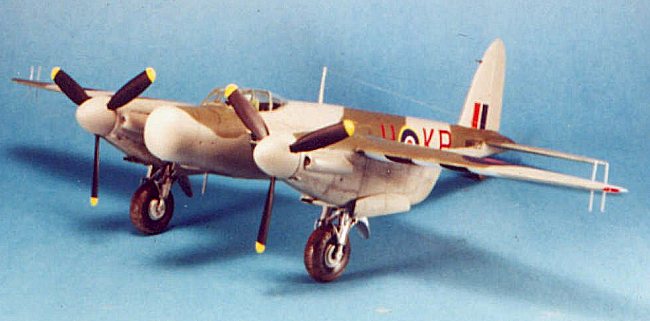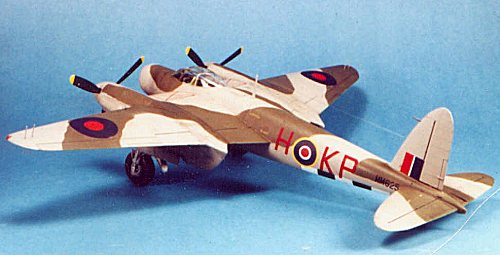
|
KIT: |
Tamiya 1/48 Mosquito NF.XIII |
|
KIT # |
61075 |
|
PRICE: |
$38.00 |
|
DECALS: |
See Review |
|
REVIEW & |
|
|
NOTES: |

|
HISTORY |
The deHavilland Mosquito, which began life as an unarmed bomber that used speed as its defense, was almost better designed to be a high-performance twin engine fighter than it was a bomber. The N.F.II was introduced into service during the course of 1942, and scored its first victory the night of May 28-29, 1942. During the next three years, night fighter Mosquitoes would destroy over 600 enemy aircraft at night over the British Isles and also destroyed 600 V-1 flying bombs over a two month period in the summer of 1944.
During 1942 and early 1943, the Mosquito revolutionized night fighting with its superior performance. It was limited however, by the use of A.I. Mk. IV, a metric-wavelength radar which did not have a performance equal to the aircraft which carried it. Centimetric-wavelength radar was developed during 1942. This radar used the spinning-dish scanner which greatly improved its performance. The first Mosquito to use this was the N.F.XII, which resulted from the conversion of 97 Mk.II airframes.
 At almost
the same time the Mk.XII was introduced, the Mk.XIII - which was based on the
F.B.VI airframe with the strengthened "universal" wing and powered by
the higher-rated Merlin 25 engine - came into service. 270 of this version were
produced. Both the Mk.XII and XIII used British-built A.I.Mk.VIII centimetric
radar, housed in a neat "thimble" radome that replaced the 4 .30
caliber machine guns in the nose of the earlier fighter variants.
At almost
the same time the Mk.XII was introduced, the Mk.XIII - which was based on the
F.B.VI airframe with the strengthened "universal" wing and powered by
the higher-rated Merlin 25 engine - came into service. 270 of this version were
produced. Both the Mk.XII and XIII used British-built A.I.Mk.VIII centimetric
radar, housed in a neat "thimble" radome that replaced the 4 .30
caliber machine guns in the nose of the earlier fighter variants.
Shortly thereafter, the American-made SCR-720 and SCR-729 centimetric radars became available, known in England as A.I. Mk.X. It performed better than its British equivalent, though it was not interchangeable with the Mk.VIII. 100 N.F.IIs were converted to the A.I.Mk.X as the N.F.XVII, while the N.F.XIX was placed in production as the equivalent version of the N.F.XIII, and a total of 220 of this version were built. These Mosquitoes differed from the other night fighter versions by the use of a universal nose - also known as a "bullnose" because of its shape - which could take either radar. About 100 late production Mk.XIII Mosquitoes were equipped with the bullnose; it is unknown which version of radar they were equipped with as this could change back and forth as different sets burned out and were replaced in service.
The Mk.XIII and XIX Mosquitoes were the first of the centimetric-equipped Mosquito night fighters to operate over the European continent, after it was discovered that the secret of the centimentric radar had been discovered by the Germans from the remains of an H2S set in a crashed Halifax. These Mosquitoes provided night air defense over northwest Europe as part of 2 Tactical Air Force from September 1944 to the end of the war. The most successful of the 2TAF squadrons was 409 "Nighthawk" Squadron, RCAF, which scored 42 kills in the last six months of the war.
|
THE KIT |
It was obvious from the release of the N.F.II/F.B.VI kit by Tamiya that the engineering of the forward section of the Mosquito fuselage would allow eventual release of both a bomber version and the later night fighter versions. This kit presents the bullnosed night fighter very well. Tamiya says it is a M.XIII, but it can be made up as either a late-production Mk.XIII or Mk.XIX, or a Mk.XVII, by use of the different wingtips and propellers applicable to the particular version.
Past the different-shaped nose, the kit also presents the different cockpit layout of the later night fighters, with different placement of the radios, and the different radar operator's installation. The model from the rear of the cockpit on is the same kit as both the fighter-bomber and bomber versions released over the past two years.
|
CONSTRUCTION |
 The
Mosquito is a model in which construction starts with the cockpit. The Mossie
cockpit is one of the better ones that
Tamiya has done with their kits, but there is room for
improvement. I had a True Details resin cockpit for the F.B.VI and decided to
use this, using the kit-supplied instrument panel, radar operator's equipment,
and radios that are specific to the later night fighter. I cut the resin parts
loose from their molding blocks and sanded their mating surfaces smooth, then
painted them British Interior Green. I detailed out the various instrument
panels, throttles, etc., with semi-gloss black and used the kit decals for the
instrument panel.
The
Mosquito is a model in which construction starts with the cockpit. The Mossie
cockpit is one of the better ones that
Tamiya has done with their kits, but there is room for
improvement. I had a True Details resin cockpit for the F.B.VI and decided to
use this, using the kit-supplied instrument panel, radar operator's equipment,
and radios that are specific to the later night fighter. I cut the resin parts
loose from their molding blocks and sanded their mating surfaces smooth, then
painted them British Interior Green. I detailed out the various instrument
panels, throttles, etc., with semi-gloss black and used the kit decals for the
instrument panel.
Past the difference of using the resin cockpit, the model was assembled in the same way as the F.B.VI kit, with the bomb bay doors closed since the night fighter did not carry a bomb armament. The Mosquito is one of the best-engineered Tamiya kits and assembles without the use of putty anywhere but the fuselage centerline to get rid of the seam. Once I had sanded that smooth I painted over with Gunze Sanyo Mr. Surfacer, then sanded it smooth with fine-grit wet 'r' dry sandpaper. I left off the landing gear for assembly after the model was painted.
|
PAINT & DECALS |
Painting:
I decided to do a Mosquito of 409 Squadron in the fall of 1944, shortly after the squadron moved to the Continent. After shadow-shading the model with black paint, I also painted the areas on the lower surfaces where the D-Day stripes would be, then masked over these and painted the white stripes. A modeler doing a Mosquito with D-Day stripes needs to remember that twin-engine aircraft had stripes that were 24 inches wide, rather than the 18-inch stripes used on single-engine aircraft. Painting the white over the black gave a weathered look to the white stripes which fit the way they looked in photographs. Once these were dry, the invasion stripes were completely masked off and I proceeded to apply the camouflage finish.
Mosquito night fighters had a camouflage finish of overall Sea Grey Medium, with a disruptive pattern in Dark Green over the upper surfaces. I used Tamiya "Medium Grey," which is an exact match for WW2-era Sea Grey Medium, and Gunze-Sanyo RAF "Dark Green" for the upper surface pattern.
At this point, I had left the canopy off, and hand-painted the bracing bars on it after it had been dipped in Future. I gave the model an overall coat of Future to prepare it for the decals.
Decals and Final Finish:
 I used
Aeromaster national insignia from a Mosquito sheet, and the kit decals for
squadron codes, individual serial number and stenciling. These all went down
easily with a coat of MicroSol. When these had set, I washed the model
thoroughly to get rid of dried decal setting solution, then gave it another coat
of Future when it was dry. When this was dry, I shot the model with "Flat
Future," a 70-30 mix of Future (70%) and Tamiya Flat Base (30%); with
several thin coats of this, the end result was an almost-but-not-quite overall
flat finish that is more accurate than a dead-flat finish.
I used
Aeromaster national insignia from a Mosquito sheet, and the kit decals for
squadron codes, individual serial number and stenciling. These all went down
easily with a coat of MicroSol. When these had set, I washed the model
thoroughly to get rid of dried decal setting solution, then gave it another coat
of Future when it was dry. When this was dry, I shot the model with "Flat
Future," a 70-30 mix of Future (70%) and Tamiya Flat Base (30%); with
several thin coats of this, the end result was an almost-but-not-quite overall
flat finish that is more accurate than a dead-flat finish.
Final Assembly and Weathering:
The landing gear, props and canopy were glued in position. Since the Mosquito was a wooden airplane, there is not a lot of weathering past the typically-British oil stains on the engine cowlings and the exhaust stains on the nacelles. I also put gunfire soot on the four 20mm cannons.
|
CONCLUSIONS |
I have always thought the bullnosed Mosquito was the most interesting-looking variant, if not the most esthetic-looking Mossie (that honor goes to the bombers). The kit makes up as well as the others, and looks good sitting next to them on the shelf.
Review kit compliments of my wallet.
If you would like your product reviewed fairly and quickly by a site that has over 1,500 visits a day, please contact me or see other details in the Note to Contributors.